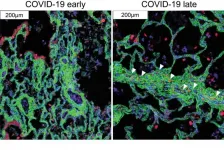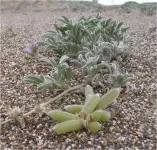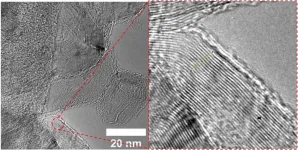(Press-News.org) A team led by investigators at Weill Cornell Medicine and NewYork-Presbyterian has used advanced technology and analytics to map, at single-cell resolution, the cellular landscape of diseased lung tissue in severe COVID-19 and other infectious lung diseases.
In the study, published online March 29 in Nature, the researchers imaged autopsied lung tissue in a way that simultaneously highlighted dozens of molecular markers on cells. Analyzing these data using novel analytical tools revealed new insights into the causes of damage in these lung illnesses and a rich data resource for further research.
"COVID-19 is a complex disease, and we still don't understand exactly what it does to a lot of organs, but with this study we were able to develop a much clearer understanding of its effects on the lungs," said co-senior author Dr. Olivier Elemento, professor of physiology and biophysics, director of the Caryl and Israel Englander Institute for Precision Medicine, associate director of the HRH Prince Alwaleed Bin Talal Bin Abdulaziz Alsaud Institute for Computational Biomedicine at Weill Cornell Medicine and co-Director of the WorldQuant Initiative for Quantitative Prediction, which funded the technology for single cell analysis of tissue. "I think the technological approach we used here is going to become standard for studying such diseases."
Traditional tissue analysis, often using chemical stains or tagged antibodies that label different molecules on cells and can reveal important features of autopsied tissues. However, this approach is limited in the number of features it can mark simultaneously. It also usually doesn't allow detailed analyses of individual cells in tissues while retaining information about where the cells were in the tissue.
The main technology the investigators employed in the study, a technology called imaging mass cytometry, largely overcomes those limitations. It uses a collection of metal-tagged antibodies that can simultaneously label up to several dozen molecular markers on cells within tissues. A special laser scans the labeled tissue sections, vaporizing the metal tags, and the metals' distinct signatures are detected and correlated with the laser position. The technique essentially maps precisely where cells are in the sample as well as each cell's surface receptors and other important identifying markers. Altogether over 650,000 cells were analyzed.
The researchers applied the method to 19 lung tissue samples autopsied from patients who had died of severe COVID-19, acute bacterial pneumonia, or bacterial or influenza-related acute respiratory distress syndrome, plus four lung tissue samples autopsied from people who had had no lung disease.
The findings in samples from COVID-19 cases were broadly consistent with what is known about the disease, but clarified this knowledge in much finer detail. They showed for example that cells called alveolar epithelial cells, which mediate the lungs' gas-exchange function, are the main targets of infection by SARS-CoV-2, the coronavirus that causes COVID-19. The analysis suggested that these infected cells are not solely singled out for attack by lung-infiltrating immune cells, which may help explain why inflammation often keeps worsening in severe COVID-19 and ends up causing such extensive and relatively indiscriminate damage.
One surprise was that age and sex, two major factors in mortality risk for COVID-19, made no apparent difference at the histologic level, once COVID-19 had progressed to the severe stage.
The results also showed that white blood cells called macrophages are much more abundant in the lungs of severe COVID-19 patients compared to other lung diseases, whereas white blood cells called neutrophils are most prevalent in bacterial pneumonia--a distinction that may be relevant to the development of future treatments for these infectious diseases.
image showing spike protein, DNA, and immune cells in lung tissue from COVID-19 patients
Immune cells (blue) surround infected lung cells (green).
Overall, the study provides a fine-grained picture of the disease process in COVID-19 and how it differs from other infectious lung diseases. It has prompted new research questions that are now being investigated, the investigators said, and includes a wealth of observations that wouldn't have been possible with standard pathology techniques.
"The application of technology like what we've demonstrated here is going to provide a huge boost to the utility of autopsy-based studies of disease," said co-senior author Dr. Alain Borczuk, professor of pathology and laboratory medicine at Weill Cornell Medicine and a pathologist at NewYork-Presbyterian/Weill Cornell Medical Center.
The researchers emphasized that the technique not only will be applicable to a broad set of other diseases for which tissue can be obtained, but also should give doctors and scientists for the first time a practical method for delineating important differences within disease categories.
"Traditionally for lung, liver, and other organ diseases we have these broad diagnoses that in fact cover multiple distinct diseases--now we have a tool that that will enable us routinely to distinguish among these different diseases, and hopefully make use of those distinctions in treating patients more effectively," said co-senior author Dr. Robert Schwartz, an associate professor of medicine in the Division of Gastroenterology and Hepatology at Weill Cornell Medicine, and a pathologist at New York-Presbyterian/Weill Cornell Medical Center. "I think this has the potential to revolutionize medicine."
INFORMATION:
The researchers have published their data at https://doi.org/10.5281/zenodo.4110560 and encourage other scientists to make use of it.
Dr. Olivier Elemento is a scientific advisor and equity holder in Freenome, Owkin, Volastra Therapeutics, and OneThree Biotech.
Researchers at the Federal University of São Carlos (UFSCar) in the state of São Paulo, Brazil, have developed a novel far red light-emitting luciferin-luciferase system that is more efficient than those available commercially. An article on the subject is published in the International Journal of Molecular Sciences.
The study was supported by São Paulo Research Foundation - FAPESP via the Thematic Project "Arthropod bioluminescence: biological diversity in Brazilian biomes, biochemical origin, structural/functional evolution of luciferases, molecular differentiation of lanterns, biotechnological, environmental and educational applications", for which the principal ...
ANN ARBOR--In a two-year study that could help guide educators developing the post-pandemic new normal, student groups at the University of Michigan assigned to make video presentations showed more creativity and risk-taking than groups making conventional in-person presentations.
"Given the importance of project-based learning, our study provides a way to turn virtual limitations into an advantage," said Fei Wen, U-M associate professor of chemical engineering. "We can enhance the student experience and learning outcomes."
Higher education, along with society at large, anticipates a shift in the balance between ...
More physicians and pharmacists are advocating for patients to be made aware of animal byproducts contained in common medications, according to new research in the Journal of Osteopathic Medicine. Common medications, including widely used blood thinners and hormones, are often derived from animal byproducts and prescribed without consulting the patient about their beliefs.
"Patients deserve to know what their medications are made of, yet this information is rarely shared," said Sara Reed, student doctor at Lincoln Memorial University (LMU) DeBusk ...
Climate change is altering the world we share with all living things. But it's surprisingly difficult to single out climate change as an extinction threat for any one particular species protected under the Endangered Species Act.
To date, the U.S. Fish and Wildlife Service has only formally considered impacts from climate change in listing actions for four animal species and one alpine tree.
But the effects of climate change extend to temperate climates as well. A new analysis of population data published in the journal Ecosphere shows that climate change represents a specific extinction threat for an endangered coastal lupine plant.
Biologists including Eleanor Pardini at Washington University in St. Louis have tracked all of the known stands ...
HOUSTON - (March 29, 2021) - This could be where the rubber truly hits the road.
Rice University scientists have optimized a process to convert waste from rubber tires into graphene that can, in turn, be used to strengthen concrete.
The environmental benefits of adding graphene to concrete are clear, chemist James Tour said.
"Concrete is the most-produced material in the world, and simply making it produces as much as 9% of the world's carbon dioxide emissions," Tour said. "If we can use less concrete in our roads, buildings and bridges, we can eliminate some of the emissions at the very start."
Recycled tire waste is already used as a component of Portland cement, but graphene has been proven to strengthen cementitious materials, ...
SUVA, Fiji (March 29, 2021) - A new study published in the journal Environmental Science and Policy addresses the impacts of COVID-19 and Cyclone Harold on Indo-Fijians engaged in small scale fisheries.
The paper says that countries, including Fiji, need to address ethical and social justice considerations and the politics of recovery efforts by putting vulnerable and marginalized groups front and center in the aftermath of pandemics and natural disasters.
What countries cannot afford is for economic recovery efforts to put additional burdens and risk on those invested in the SSF sector, and cause further widening of inequities, and increase ...
A new study out of the University of Chicago and the University of Illinois Urbana-Champaign in humans, chimpanzees, rhesus macaques and baboons has found key differences in early gene expression in response to pathogen exposure, highlighting the importance of choosing the right animal model for the right questions. The study was published on March 26 in END ...
A national survey of parents revealed that most parents who used ride-share services did so with their children, but only half of the respondents reported that children who were 8 years or younger traveled in the recommended child car seats or booster seats when in ride-share vehicles. Among parents of children in this age group, over 40 percent used only a seat belt for their child, while 10 percent allowed their child to travel on a lap or unrestrained. Overall, parents reported lower rates of child car seat use in ride-share compared with how their child usually travels. Findings were published in the journal Academic Pediatrics.
"Our results are concerning, as ...
Barcelona researchers at the Hospital Clínic-IDIBAPS Research Institute, the University of Barcelona and the SOLTI academic cancer research group have shown that the molecular classification of breast cancer, which divides it into four subtypes (Luminal A, Luminal B, HER2-enriched and Basal-like) is useful for predicting the benefits of treatment in patients with advanced hormone-sensitive breast cancer. This is the largest study to have shown the value of the biomarker, and the first to do so in the context of a CDK4/6 inhibitor like ribociclib.
The study, published in the Journal of Clinical Oncology of the American Society of Clinical Oncology (ASCO), was coordinated by Professor Aleix Prat, head of the Medical Oncology ...
CHAPEL HILL, NC - A team led by scientists at the UNC School of Medicine discovered an important vulnerability of the AIDS-causing retrovirus HIV, and has shown in preclinical experiments that a widely used diabetes drug, metformin, seems able to exploit this vulnerability.
The scientists, whose study is published in Nature Immunology, found that HIV, when it infects immune cells called CD4 T cells, helps fuel its own replication by boosting a key process in the cells' production of chemical energy. They also found that the diabetes drug metformin inhibits the same process and thereby suppresses HIV replication in these cells, in both cell-culture and mouse experiments.
"These findings suggest that metformin and other drugs that reduce T cell metabolism ...




